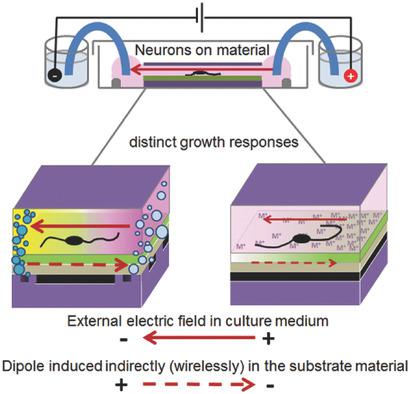当前位置:
X-MOL 学术
›
Adv. Healthcare Mater.
›
论文详情
Our official English website, www.x-mol.net, welcomes your
feedback! (Note: you will need to create a separate account there.)
Controlling Nerve Growth with an Electric Field Induced Indirectly in Transparent Conductive Substrate Materials
Advanced Healthcare Materials ( IF 10.0 ) Pub Date : 2018-07-05 , DOI: 10.1002/adhm.201800473 Ann M. Rajnicek 1 , Zhiqiang Zhao 1 , Javier Moral-Vico 2 , Ana M. Cruz 2 , Colin D. McCaig 1 , Nieves Casañ-Pastor 2
Advanced Healthcare Materials ( IF 10.0 ) Pub Date : 2018-07-05 , DOI: 10.1002/adhm.201800473 Ann M. Rajnicek 1 , Zhiqiang Zhao 1 , Javier Moral-Vico 2 , Ana M. Cruz 2 , Colin D. McCaig 1 , Nieves Casañ-Pastor 2
Affiliation

|
Innovative neurostimulation therapies require improved electrode materials, such as poly(3,4‐ethylenedioxythiophene) (PEDOT) polymers or IrOx mixed ionic–electronic conductors and better understanding of how their electrochemistry influences nerve growth. Amphibian neurons growing on transparent films of electronic (metal) conductors and electronic–ionic conductors (polymers and semiconducting oxides) are monitored. Materials are not connected directly to the power supply, but a dipole is created wirelessly within them by electrodes connected to the culture medium in which they are immersed. Without electrical stimulation neurons grow on gold, platinum, PEDOT‐polystyrene sulfonate (PEDOT‐PSS), IrOx, and mixed oxide (Ir‐Ti)Ox, but growth is not related to surface texture or hydrophilicity. Stimulation induces a dipole in all conductive materials, but neurons grow differently on electronic conductors and mixed‐valence mixed‐ionic conductors. Stimulation slows, but steers neurite extension on gold but not on platinum. The rate and direction of neurite growth on PEDOT‐PSS resemble that on glass, but on IrOx and (Ir‐Ti)Ox neurites grow faster and in random directions. This suggests electrochemical changes induced in these materials control growth speed and direction selectively. Evidence that the electric dipole induced in conductive material controls nerve growth will impact electrotherapies exploiting wireless stimulation of implanted material arrays, even where transparency is required.
中文翻译:

用透明导电基底材料中间接感应的电场控制神经的生长
创新的神经刺激疗法需要改进的电极材料,例如聚(3,4-乙撑二氧噻吩)(PEDOT)聚合物或IrO x混合离子电子导体,并需要更好地了解其电化学如何影响神经生长。监测在电子(金属)导体和电子离子导体(聚合物和半导体氧化物)的透明膜上生长的两栖神经元。材料没有直接连接到电源,而是通过连接到其所浸入培养基中的电极在其中以无线方式产生偶极子。在没有电刺激的情况下,神经元会在金,铂,PEDOT-聚苯乙烯磺酸盐(PEDOT-PSS),IrO x和混合氧化物(Ir-Ti)O x上生长,但增长与表面质地或亲水性无关。刺激会在所有导电材料中诱发偶极子,但神经元在电子导体和混合价混合离子导体上的生长方式有所不同。刺激减慢,但引导神经突延伸到金而不是铂上。PEDOT-PSS上神经突生长的速率和方向类似于玻璃上的,但IrO x和(Ir-Ti)O x上神经突的生长速度更快且方向随机。这表明在这些材料中引起的电化学变化选择性地控制了生长速度和方向。即使在需要透明性的情况下,在导电材料中感应出的电偶极子也会控制神经生长的证据将通过无线刺激植入材料阵列来影响电疗法。
更新日期:2018-07-05
中文翻译:

用透明导电基底材料中间接感应的电场控制神经的生长
创新的神经刺激疗法需要改进的电极材料,例如聚(3,4-乙撑二氧噻吩)(PEDOT)聚合物或IrO x混合离子电子导体,并需要更好地了解其电化学如何影响神经生长。监测在电子(金属)导体和电子离子导体(聚合物和半导体氧化物)的透明膜上生长的两栖神经元。材料没有直接连接到电源,而是通过连接到其所浸入培养基中的电极在其中以无线方式产生偶极子。在没有电刺激的情况下,神经元会在金,铂,PEDOT-聚苯乙烯磺酸盐(PEDOT-PSS),IrO x和混合氧化物(Ir-Ti)O x上生长,但增长与表面质地或亲水性无关。刺激会在所有导电材料中诱发偶极子,但神经元在电子导体和混合价混合离子导体上的生长方式有所不同。刺激减慢,但引导神经突延伸到金而不是铂上。PEDOT-PSS上神经突生长的速率和方向类似于玻璃上的,但IrO x和(Ir-Ti)O x上神经突的生长速度更快且方向随机。这表明在这些材料中引起的电化学变化选择性地控制了生长速度和方向。即使在需要透明性的情况下,在导电材料中感应出的电偶极子也会控制神经生长的证据将通过无线刺激植入材料阵列来影响电疗法。











































 京公网安备 11010802027423号
京公网安备 11010802027423号